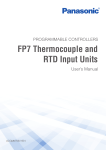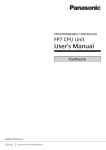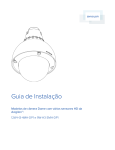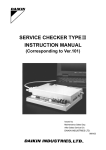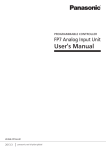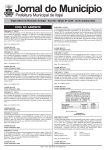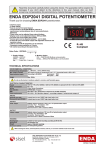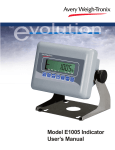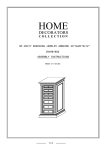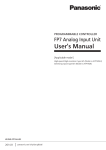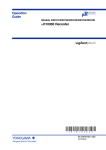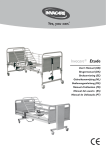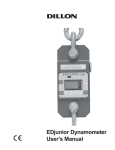Download FP7 TC Multi-analog Input Unit/ RTD Input Unit User`s Manual
Transcript
Safety Precautions Observe the following notices to ensure personal safety or to prevent accidents. To ensure that you use this product correctly, read this User’s Manual thoroughly before use. Make sure that you fully understand the product and information on safety. This manual uses two safety flags to indicate different levels of danger. WARNING If critical situations that could lead to user’s death or serious injury is assumed by mishandling of the product. -Always take precautions to ensure the overall safety of your system, so that the whole system remains safe in the event of failure of this product or other external factor. -Do not use this product in areas with inflammable gas. It could lead to an explosion. -Exposing this product to excessive heat or open flames could cause damage to the lithium battery or other electronic parts. CAUTION If critical situations that could lead to user’s injury or only property damage is assumed by mishandling of the product. -To prevent excessive exothermic heat or smoke generation, use this product at the values less than the maximum of the characteristics and performance that are assured in these specifications. -Do not dismantle or remodel the product. It could cause excessive exothermic heat or smoke generation. -Do not touch the terminal while turning on electricity. It could lead to an electric shock. -Use the external devices to function the emergency stop and interlock circuit. -Connect the wires or connectors securely. The loose connection could cause excessive exothermic heat or smoke generation. -Do not allow foreign matters such as liquid, flammable materials, metals to go into the inside of the product. It could cause excessive exothermic heat or smoke generation. -Do not undertake construction (such as connection and disconnection) while the power supply is on. It could lead to an electric shock. Copyright / Trademarks -This manual and its contents are copyrighted. -You may not copy this manual, in whole or part, without written consent of Panasonic Industrial Devices SUNX Co., Ltd. -Windows is a registered trademark of Microsoft Corporation in the United States and other countries. -All other company names and product names are trademarks or registered trademarks of their respective owners. PLC_ORG Introduction Thank you for buying a Panasonic product. Before you use the product, please carefully read the installation instructions and the users manual, and understand their contents in detail to use the product properly. Types of Manual • There are different types of users manual for the FP7 series, as listed below. Please refer to a relevant manual for the unit and purpose of your use. • The manuals can be downloaded on our website: http://industrial.panasonic.com/ac/e/dl_center/manual/ . Unit name or purpose of use FP7 Power Supply Unit FP7 CPU Unit Manual name Manual code FP7 CPU Unit Users Manual (Hardware) WUME-FP7CPUH FP7 CPU Unit Command Reference Manual WUME-FP7CPUPGR FP7 CPU Unit Users Manual (Logging Trace Function) WUME-FP7CPULOG FP7 CPU Unit Users Manual (Security Function) WUME-FP7CPUSEC FP7 CPU Unit Users Manual (LAN Port Communication) WUME-FP7LAN FP7 series Users Manual (SCU communication) WUME-FP7COM FP7 Extension Cassette (Communication) (Ethernet type) FP7 series Users Manual (Communication cassette Ethernet type) WUME-FP7CCET FP7 Extension (Function) Cassette Analog Cassette FP7 Analog Cassette Users Manual WUME-FP7FCA Instructions for Built-in LAN Port Instructions for Built-in COM Port FP7 Extension Cassette (Communication) (RS-232C/RS485 type) ii FP7 Digital Input/Output Unit FP7 Digital Input/Output Unit Users Manual WUME-FP7DIO FP7 Analog Input Unit FP7 Analog Input Unit Users Manual WUME-FP7AIH FP7 Analog Output Unit FP7 Analog Output Unit Users Manual WUME-FP7AOH FP7 Thermocouple Multianalog Input Unit WUME-FP7TCRTD FP7 RTD Input Unit FP7 Thermocouple Multi-analog Input Unit FP7 RTD Input Unit Users Manual FP7 High-speed counter Unit FP7 High-speed counter Unit Users Manual WUME-FP7HSC FP7 Pulse Output Unit FP7 Pulse Output Unit Users Manual WUME-FP7PG FP7 Positioning Unit FP7 Positioning Unit Users Manual WUME-FP7POSP FP7 Serial Communication Unit FP7 series Users Manual (SCU communication) WUME-FP7COM PHLS System PHLS System Users Manual WUME-PHLS Programming Software FPWIN GR7 FPWIN GR7 Introduction Guidance WUME-FPWINGR7 Table of Contents Table of Contents 1. Unit Functions and Restrictions ....................................... 1-1 1.1 1.2 Unit Functions and How They Work ...................................................... 1-2 1.1.1 Functions of Unit ..................................................................................... 1-2 1.1.2 Unit Type and Product Number............................................................... 1-3 Restrictions on Combinations of Units ................................................... 1-4 1.2.1 Restrictions on Power Consumption ....................................................... 1-4 1.2.2 Applicable Versions of Unit and Software ............................................... 1-4 2. Names and Functions of Parts .......................................... 2-1 2.1 Thermocouple Multi-analog Input Unit and RTD Input Unit ................... 2-2 3. Wiring .................................................................................. 3-1 3.1 3.2 3.3 Wiring of Terminal Block ....................................................................... 3-2 3.1.1 Terminal Block, Suitable Wires and Tools .............................................. 3-2 3.1.2 Wiring ...................................................................................................... 3-3 Connection of Thermocouple Multi-analog Input Unit ............................ 3-5 3.2.1 For Thermocouple Input .......................................................................... 3-5 3.2.2 For Voltage Input ..................................................................................... 3-6 3.2.3 For Current Input ..................................................................................... 3-7 Connection of RTD Input Unit ............................................................... 3-8 4. Unit Settings and Data Reading ........................................ 4-1 4.1 Confirming the I/O Number Allocations and Starting Word Number ...... 4-2 iii 4.2 4.3 4.1.1 Occupied I/O Area and I/O Allocation ..................................................... 4-2 4.1.2 Confirming Allocation of I/O Numbers ..................................................... 4-4 Configuration Settings ...........................................................................4-5 4.2.1 Unit Configuration .................................................................................... 4-5 4.2.2 Unit Setting and Conversion Processing Time........................................ 4-8 Reading Analog Input Data....................................................................4-9 4.3.1 4.4 Reading Analog Input Data ..................................................................... 4-9 Data Acquisition Timing ....................................................................... 4-10 5. Conversion Characteristics of Analog Input ................... 5-1 5.1 5.2 Input Conversion Characteristics (AFP7TC8) ........................................ 5-2 5.1.1 Thermocouple Input Range ..................................................................... 5-2 5.1.2 Voltage Input Range................................................................................ 5-4 5.1.3 Current Input Range ................................................................................ 5-6 Input Conversion Characteristics (AFP7RTD8)...................................... 5-7 5.2.1 RTD Input Range .................................................................................... 5-7 6. Optional settings ............................................................... 6-1 6.1 iv Average Processing Settings .................................................................6-2 6.1.1 Number of Averaging Times ................................................................... 6-2 6.1.2 Time Average .......................................................................................... 6-3 6.1.3 Moving Average ...................................................................................... 6-4 6.2 Offset/Gain Processing ..........................................................................6-5 6.3 Scale Conversion (AFP7TC8 Voltage/Current Range Only) .................. 6-7 6.4 Comparison for Upper and Lower Limits................................................ 6-8 6.5 Holding Maximum and Minimum Values .............................................. 6-11 6.6 Disconnection Detection (AFP7TC8) ................................................... 6-14 Table of Contents 6.7 Disconnection Detection (AFP7RTD8) ................................................ 6-16 6.8 Configuration by Programming ............................................................ 6-17 7. What to Do If an Error Occurs ........................................... 7-1 7.1 What to Do If an Error Occurs (Analog Input) ........................................ 7-2 7.1.1 Failure in Reading Input Data ................................................................. 7-2 7.1.2 Unstable Input Conversion Value............................................................ 7-2 7.1.3 No Proper Conversion Values Obtained with Current Input ................... 7-2 8. Specifications ..................................................................... 8-1 8.1 Specifications ........................................................................................ 8-3 8.1.1 General Specifications ............................................................................ 8-3 8.1.2 Specifications of Thermocouple Multi-analog Input Unit (AFP7TC8) ..... 8-4 8.1.3 Specifications of RTD Unit (AFP7RTD8) ................................................ 8-7 8.2 I/O Allocation ........................................................................................ 8-8 8.3 List of Unit Memories .......................................................................... 8-10 8.3.1 Configuration Area ................................................................................ 8-10 8.4 List of Detailed Specifications of Unit Memories .................................. 8-12 8.5 Dimensions ......................................................................................... 8-17 v 1 Unit Functions and Restrictions Unit Functions and Restrictions 1.1 Unit Functions and How They Work 1.1.1 Functions of Unit Analog input control is available in combination with the CPU unit. • Temperature data measured by a thermocouple or resistance temperature detector (RTD) is converted as digital values. Input with simple programs • For input data, digital conversion values are read as input devices (WX). • At the time of the thermocouple input or the RTD input, temperatures are read as integer values in units of 0.1 degrees. Ten types of thermocouples and three types of RTDs are supported for each channel. • Ten types of thermocouples (K, J, T, N, R, S, B, E, PLII and WRe5-26) and three types of RTDs (Pt100, JPt100 and Pt1000) can be used. Also, on the thermocouple multi-analog input unit, they can be used in combination with volotage and current inputs. • Types of temperature sensors can be changed by the settings of tool software or user programs. 1-2 1.1 Unit Functions and How They Work Various optional settings Functions to process loaded analog input data are provided. User programs can be simplified. Function Specifications Average processing setting Averages analog values obtained by sampling and stores them in the I/O area as digital values. It can be selected from No. of averaging times, time average and moving average. Offset/Gain processing setting Performs the correction of offset values (addition correct) or gain values (magnification correction), and stores the data after processing in the I/O area. (Only the voltage and current ranges of the thermocouple mult-analog input unit) Scale conversion setting The function makes it possible to convert values to an easy-to-use data range. Analog input data acquired in a range between preset minimum and maximum values is scale converted and stored in the I/O area. This function is convenient if used for scale unit conversion. Upper/lower limit value comparison setting This function compares acquired data with the upper limit and lower limit and turns ON the upper limit relay or lower limit relay if the acquired data exceeds the upper limit value or lower limit value. Max./Min. hold setting This function maintains the maximum and minimum values of acquired data. Holds the maximum and minimum digital conversion values when the maximum/minimum value hold setting is enabled, and stores the values in provided unit memories for each channel. (Thermocouple multi-analog input unit) Disconnection detection Turns ON the disconnection detection flag when input is disconnected or unconnected when selecting the thermocouple or the range of 1-5 V 4-20 mA, and warns of the error state. Also, in case of thermocouple, converts values to digital values in the range (K30000) which are different from those normally converted. (RTD input unit) When the A terminal and b terminal or B terminal and b terminal are disconnected, converts values to digital values in the range (K30000) which are different from those normally converted, and warns of the error state. 1.1.2 Unit Type and Product Number Name Specifications Product No. Thermocouple input range: K1, K2, J1, J2, T, N, R, S, B, E, PLⅡ, WRe5-26 Thermocouple multianalog input unit 8-ch input Voltage input range: -10 to +10 V, 0 to +5 V, 1 to +5 V, -100 to +100 mV AFP7TC8 Current input range: 0 to +20 mA, 4 to +20 mA RTD input unit 8-ch input RTD input range Pt100-1, Pt100-2, JPt100-1, JPt100-2, Pt1000 AFP7RTD8 1-3 Unit Functions and Restrictions 1.2 Restrictions on Combinations of Units 1.2.1 Restrictions on Power Consumption The internal current consumption of the unit is as follows. Make sure that the total current consumption is within the capacity of the power supply with consideration of all other units used in combination with this unit. Name Product No. Consumption current Thermocouple multi-analog input unit AFP7TC8 80 mA or less RTD input unit AFP7RTD8 65 mA or less 1.2.2 Applicable Versions of Unit and Software For using the above function cassettes, the following versions of unit and software are required. Item Applicable version FP7 CPU unit Ver.2.0 or later Programmingn tool software FPWINGR7 Ver.2.2 or later 1-4 2 Names and Functions of Parts Names and Functions of Parts 2.1 Thermocouple Multi-analog Input Unit and RTD Input Unit Names and Functions of Parts (1) Operation monitor LEDs LED name LED color Contents - Blue Lit when the CPU unit is turned ON. ERROR Red Lit when the configuration settings are beyond the allowable range or A/D conversion is not possible. ALARM Red Lit when the hardware has an error. (2) Analog input terminal block The terminal block is removable. Remove the terminal block before wiring. (3) DIN rail attachment lever This lever is used to fix the unit to the DIN rail. (4) Unit connector Connects to other I/O units and highly-functional units. (5) Fixing hook This hook is used to secure the unit with another unit. 2-2 3 Wiring Wiring 3.1 Wiring of Terminal Block 3.1.1 Terminal Block, Suitable Wires and Tools Supplied terminal block and suitable wires A screw-down connection type is used for the terminal block. Use the following suitable wires for the wiring. Terminal block socket No. of pins 18 pins Phoenix Contact model No. Part number Product No. MC1,5/18-ST-3,5BK 1840528 Suitable wires (strand wire) No. of wires Size Nominal crosssectional area 1 AWG#28 to 16 0.08 mm2 to 1.25 mm2 2 AWG#28 to 20 0.08 mm2 to 0.5 mm2 Pole terminals with compatible insulation sleeve If a pole terminal is being used, the following models (made by Phoenix Contact) should be used. Manufacturer Phoenix Contact Crosssectional area Size Phoenix Contact Par No. With insulating sleeve Without insulating sleeve AWG#24 AI 0,25-6 BU A 0,25-7 AWG#22 AI 0,34-6TQ A 0,34-7 AWG#20 AI 0,5-6 WH A 0,5-6 2 AWG#18 AI 0,75-6 GY A 0,75-6 1.00 mm2 AWG#16 - A 1-6 0.5 mm2×2 AWG#20×2 AI-TWIN 2X 0,5-8 WH - 0.25 mm 2 0.34 mm 2 0.50 mm2 0.75 mm Pressure welding tool for pole terminals Manufacturer Phoenix Contact 3-2 Phoenix Contact model No. Part number Product No. CRIMPFOX 6 1212034 3.1 Wiring of Terminal Block 3.1.2 Wiring Wiring method (1) Insert a screwdriver between the terminal block and the case, and remove the terminal block. (2) Remove a portion of the wire's insulation. (3) Insert the wire into the terminal block until it contacts the back of the block socket, and then tighten the screw clockwise to fix the wire in place. (4) Fit the terminal block into the unit securely. 3-3 Wiring Tightening the terminal block • When tightening the terminals of the terminal block, use a screwdriver (Phoenix Contact, Product No. 1205037) with a blade size of 0.4 x 2.5 (Part No. SZS 0,4x2,5). • The tightening torque should be 0.22 to 0.25 N·m. Precautions on wiring The following precautions should be observed, to avoid broken or disconnected wires. • When removing the wire's insulation, be careful not to scratch the core wire. • Do not twist the wires to connect them. • Do not solder the wires to connect them. The solder may break due to vibration. • After wiring, make sure stress is not applied to the wire. • In the terminal block socket construction, if the wire is fastened upon counter-clockwise rotation of the screw, the connection is faulty. Disconnect the wire, check the terminal hole, and then re-connect the wire. 3-4 3.2 Connection of Thermocouple Multi-analog Input Unit 3.2 Connection of Thermocouple Multi-analog Input Unit 3.2.1 For Thermocouple Input Wiring Diagram and Internal Circuit Diagram Terminal layout (Note) Do not connect anything to N.C terminals. • Connect wires in accordance with the polarity of he thermocouple. Also, when extending the signal line of the thermocouple, use the compensating lead wire for the used thermocouple. It is recommended to ground the unit using the shielded compensating lead wire. • Do not have the analog input wiring close to AC wires, power wires, or load line from a device other than PLC. Also, do not bundle it with them. 3-5 Wiring 3.2.2 For Voltage Input Wiring Diagram and Internal Circuit Diagram Terminal layout (Note) Do not connect anything to N.C terminals. 3-6 • Use double-core twisted-pair shielded wires. It is recommended to ground them. However, depending on the conditions of the external noise, it may be better not to ground the shielding. • Do not have the analog input wiring close to AC wires, power wires, or load line from a device other than PLC. Also, do not bundle it with them. 3.2 Connection of Thermocouple Multi-analog Input Unit 3.2.3 For Current Input Wiring Diagram and Internal Circuit Diagram In case of the current input, connect In terminals each other. Terminal layout (Note) Do not connect anything to N.C terminals. • Use double-core twisted-pair shielded wires. It is recommended to ground them. However, depending on the conditions of the external noise, it may be better not to ground the shielding. • Do not have the analog input wiring close to AC wires, power wires, or load line from a device other than PLC. Also, do not bundle it with them. 3-7 Wiring 3.3 Connection of RTD Input Unit Wiring Diagram and Internal Circuit Diagram Terminal layout (Note) Do not connect anything to N.C terminals. 3-8 • For copper wires for wiring, use thick wires having insulation performance of JISC3307 and JISC3401 or equivalents to prevent a large increase in the electric resistance. It is recommended to ground the unit using the shielded compensating lead wire. • Do not have the analog input wiring close to AC wires, power wires, or load line from a device other than PLC. Also, do not bundle it with them. 4 Unit Settings and Data Reading Unit Settings and Data Reading 4.1 Confirming the I/O Number Allocations and Starting Word Number 4.1.1 Occupied I/O Area and I/O Allocation • Input data is allocated to the external input relay areas (WX). • To the I/O areas of the thermocouple multi analog input unit and RTD input unit, an area to set optional functions and an area to reset errors are allocated. Input contact I/O area No. Name Default WX0 CH0 Analog conversion data K0 WX1 CH0 Optional function flag H0 WX2 CH1 Analog conversion data K0 WX3 CH1 Optional function flag H0 WX4 CH2 Analog conversion data K0 WX5 CH2 Optional function flag H0 WX6 CH3 Analog conversion data K0 WX7 CH3 Optional function flag H0 WX8 CH4 Analog conversion data K0 WX9 CH4 Optional function flag H0 WX10 CH5 Analog conversion data K0 WX11 CH5 Optional function flag H0 WX12 CH6 Analog conversion data K0 WX13 CH6 Optional function flag H0 WX14 CH7 Analog conversion data K0 WX15 CH7 Optional function flag H0 Description Analog conversion data area Digital conversion values corresponding to analog input are stored as 16-bit signed integer data. Stored values vary by ranges. When optional average processing, scale conversion, offset/gain processing has been set, data after the processing is stored. Optional function flag area Refer to the next page. (Note 1): The I/O numbers in the table indicates offset addresses. The I/O numbers actually allocated are the numbers based on the starting word number allocated to the unit. Example) When the starting word number for the unit is "10", the A/D conversion data of CH0 is WX10 and the error flag is X11F. 4-2 4.1 Confirming the I/O Number Allocations and Starting Word Number Input contact (Optional functions/Error flag area) I/O number CH0 CH1 CH2 CH3 CH4 CH5 CH6 CH7 Name Description ON with disconnection detected and OFF with disconnection restored. (Valid for thermocouple, voltage:1-5 V and current: 4-20 mA ranges only) X10 X30 X50 X70 X90 X110 X130 X150 Disconnection detection flag X11 X31 X51 X71 X91 X111 X131 X151 Upper limit comparison relay Turns ON when the value exceeds the set upper limit. X12 X32 X52 X72 X92 X112 X132 X152 Lower limit comparison relay Turns OFF when the value drops below the set lower limit. X13 X33 X53 X73 X93 X113 X133 X153 Upper/Lower limit comparison execution flag Turns ON when the upper limit/lower limit comparison function is executed. X14 X34 X54 X74 X99 X114 X134 X154 Not used Do not use. X15 X35 X55 X75 X95 X115 X135 X155 Max./Min. hold execution flag Turns ON when the max./min. hold function is executed. X16 to X1E X36 to X3E X56 to X5E X76 to X7E X96 to X9E X116 X136 X156 to to to X11E X13E X15E Not used Do not use. X1F X3F X5F X7F X9F X11F X13F X15F Error flag Turns ON when an error occurs (Note 1): The I/O numbers in the table indicates offset addresses. The I/O numbers actually allocated are the numbers based on the starting word number allocated to the unit. Example) When the starting word number for the unit is "10", the C error flag is X11F. Output flag I/O number CH0 CH1 CH2 CH3 CH4 CH5 CH6 CH7 Name Description ON to execute the disconnection detection function. OFF to turn OFF the disconnection detection flag (Xn0). (Valid for thermocouple, voltage:1-5 V and current: 4-20 mA ranges only) Y0 Y10 Y20 Y30 Y40 Y50 Y60 Y70 Disconnection detection execution relay Y1 Y2 Y11 Y12 Y21 Y22 Y31 Y32 Y41 Y42 Y51 Y52 Y61 Y62 Y71 Y72 Not used Do not use. ON to execute the function to compare the upper and lower limits. OFF to turn OFF the upper limit comparison relay (Xn1) and lower limit comparison relay (Xn2). Y3 Y13 Y23 Y33 Y43 Y53 Y63 Y73 Upper/Lower limit comparison execution relay Y4 Y14 Y24 Y34 Y44 Y54 Y64 Y74 Not used Do not use. ON to execute the max./min. hold function. Y5 Y15 Y25 Y35 Y45 Y55 Y65 Y75 Max./Min. hold execution relay Y6 to YE Y16 to Y1E Y26 to Y2E Y36 to Y3E Y46 to Y4E Y56 to Y5E Y66 to Y6E Y76 to Y7E Not used Do not use. YF Y1F Y2F Y3F Y4F Y5F Y6F Y7F Error flag reset relay Resets an error flag. (Note 1): The I/O numbers in the table indicates offset addresses. The I/O numbers actually allocated are the numbers based on the starting word number allocated to the unit. Example) When the starting word number for the unit is "10", the disconnection detection execution relay of CH0 is Y100, and the error flag reset relay is Y10F. 4-3 Unit Settings and Data Reading 4.1.2 Confirming Allocation of I/O Numbers • The I/O numbers and base word numbers are always necessary when creating programs. Always check to see if the numbers match the design. • The I/O numbers allocated to the analog input unit are determined by the starting word numbers. Allocation method Take the following procedure to set the starting word number. PROCEDURE 1. Select "Options" > "FP7 Configuration" in the menu bar. 2. Select "I/O map" in the field. 3. Double-click the target slot where the operating unit is to be inserted. 4. Select "Thermocouple Multi-analog Input Unit" or "RTD Input Unit" in the field of "Select unit to use". 5. Press the [OK] button. The specified starting word number is set. 4-4 4.2 Configuration Settings 4.2 Configuration Settings 4.2.1 Unit Configuration The settings for the unit such as input range, channels to be converted and optional functions are specified in the configuration menu of tool software. Setting method The following procedure describes the process when the thermocouple multi-analog input unit or RTD input unit has been already allocated in the I/O map. PROCEDURE 1. Select "Options" > "FP7 Configuration" in the menu bar. 2. Select "I/O Map" in the field. 3. Select the slot where the unit has been registered, and press the "Advanced" button. "Thermocouple multi-analog input unit" or "RTD input unit" setting dialog box is displayed. 4. Select items according to the conditions used. Select optional settings as necessary. 5. Press the [OK] button. The set values will be effective when they are downloaded with programs as a project. 4-5 Unit Settings and Data Reading Settings Group Basic setting item (Common) Setting item 60Hz/50Hz 60 Hz Conversion time (Note) 25ms/5ms 25 ms Conversion processing Execute/Not execute Execute Range setting (TC unit) Range setting (RTD unit) K1 (-100.0 to 600.0 °C) K2 (-200.0 to 1000.0 °C) J1 (-100.0 to 400.0 °C) J2 (-200.0 to 750.0 °C) T (-270.0 to 400.0 °C) N (-270.0 to 1300.0 °C) R (0.0 to 1760.0 °C) S (0.0 to 1760.0 °C) B (0.0 to 1820.0 °C) E (-270.0 to 1000.0 °C) PLⅡ (0.0 to 1390.0 °C) WRe5-26 (0.0 to 2315.0 °C) Voltage -10 to +10 V 0 to +5 V +1 to +5 V -100 to +100 mV Current 0 to +20 mA +4 to +20 mA Pt100-1 (-100.0 to 200.0 °C) Pt100-2 (-200.0 to 650.0 °C) JPt100-1 (-100.0 to 200.0 °C) JPt100-2 (-200.0 to 650.0 °C) Pt1000 (-100.0 to 100.0 °C) (Note) Conversion time can be set only when selecting the thermocouple multi-analog input unit. 4-6 Default Power frequency Thermocouple Basic setting item (for each channel) Settings -10 to +10 V Pt100-1 (-100.0 to 200.0 °C) 4.2 Configuration Settings Settings Group Optional setting item (For each CH) Setting item Settings Default Average processing settings Not execute/No. of averaging times/Time average/Moving average Not execute Offset/Gain processing Not execute/Execute Not execute Scale conversion(Note) Not execute/Execute Not execute Upper/Lower limit comparison Not execute/Execute Not execute Max./Min. hold Not execute/Execute Not execute Disconnection detection Not execute/Execute Not execute Disconnection detection reset Auto/Manual Auto No. of times: 2 to 60000 [times] 8 Averaging constant Time: 200 to 60000 [ms] 200 Moving: 3 to 64 [times] 8 Offset value -3000 to +3000 0 Gain value +9000 to +11000 +10000 Maximum value of scale conversion (Note) -30000 to +30000 +10000 Minimum value of scale conversion (Note) -30000 to +30000 0 Upper limit comparison ON level -31250 to +31250 +1000 Upper limit comparison OFF level -31250 to +31250 +1000 Lower limit comparison ON level -31250 to +31250 0 Lower limit comparison OFF level -31250 to +31250 0 (Note) Scale conversion can be set only when selecting voltage or current range in the thermocouple multi-analog input unit. 4-7 Unit Settings and Data Reading 4.2.2 Unit Setting and Conversion Processing Time Conversion time varies with the configuration setting conditions. Unit's conversion process cycle time • The unit's conversion time is determined by the number of channels that the conversion process is executed. • For the thermocouple multi-analog input unit, a conversion time per channel can be selected. Normal mode (When conversion time is 25 ms/ch) High-speed mode (When conversion time is 5 ms/ch) (Note 2) No. of executed channels (Note 1) No. of executed channels (Note 1) Conversion time + Processing time Conversion time + Processing time 1 25 ms + 25 ms 1 5 ms + 5 ms 2 50 ms + 25 ms 2 10 ms + 5 ms 3 75 ms + 25 ms 3 15 ms + 5 ms 4 100 ms + 25 ms 4 20 ms + 5 ms 5 125 ms + 25 ms 5 25 ms + 5 ms 6 150 ms + 25 ms 6 30 ms + 5 ms 7 175 ms + 25 ms 7 35 ms + 5 ms 8 200 ms +25 ms 8 40 ms + 5 ms (Note 1) Channels to execute the conversion processing are set in the unit memories (UM00080/UM00090/UM000A0/UM000B0/UM000C0/UM000D0/UM000E0/UM000F0). (Note 2) Conversion time can be set only when selecting the thermocouple multi-analog input unit. It is set in the unit memory (UM00071). Normal mode and High-speed mode • In the normal mode (conversion time: 25 ms/c), a process is available to reduce the effects of commercial frequency (50Hz/60Hz) noises by a digial filter. In the high-speed mode (conversion time: 5 ms/ch), this process is not available. • When there are effects of commercial frequency (50Hz/60Hz) noises, it is recommended to use the normal mode. Conversion processing execution/non-execution setting and conversion processing time Select the execution or non-execution of the conversion processing of analog input on a channel-by-channel basis. This can save the conversion time for channels that do not execute conversion processing. Example) Conversion time for two channels (with CH2 to CH7 excluded) Conversion is executed in the order of ch0→ch1→ch0→ch1→ch0→ch1→ch0→ch1→.., and the conversion time for CH2 to CH7, which are excluded, is saved. 4-8 4.3 Reading Analog Input Data 4.3 Reading Analog Input Data 4.3.1 Reading Analog Input Data Basic operation of analog input processing (1) Receiving analog input The input part of the unit receives analog input data from the thermocouple, RTD or external devices. (2) Digital conversion processing Analog input data received by the unit is converted into digital values in sequence automatically in the unit. The converted digital value varies with the setting of the range. (3) Storage of digital values A user program is used to read converted digital values as data in the unit relay area (WX). The specified area number varies depending on the installation position of the unit. Program to acquire converted digital values Reading the values in digital conversion value storage areas WX10, WX12, WX14, and WX16 to any areas of data registers ranging from DT100 to DT103. R0 MV.SS WX10 CH0 input DT100 MV.SS WX12 CH1 input DT101 MV.SS WX14 CH2 input DT102 MV.SS WX106 CH3 input DT103 Transfer digital data stored in analog input areas WX10, WX12, WX14 and WX16 to data registers ranging from DT100 to DT103. 4-9 Unit Settings and Data Reading 4.4 Data Acquisition Timing Input conversion processing time of the unit Conversion processing time varies with the range and the number of channels in use. The conversion execution/non-execution channel function can save the conversion time for channels that do no execute conversion processing. Example of 2-channel conversion Converted in the order of ch0→ch1→ch0→ch1→... Data acquisition timing of CPU unit • Digital values converted by the unit are input into the CPU unit at the I/O refreshing timing of the CPU unit. • The conversion processing of the analog input unit is not synchronized with the I/O refreshing timing of the CPU unit. Therefore, the latest data is input into the operation memory of the CPU unit when the CPU unit implements I/O refreshing. Example of 4-channel conversion b c a d Analog signal of ch0 Processing in the analog input part e Converts in the order of CH0→CH1→CH2→CH3 0 1 2 3 0 1 2 3 0 1 2 3 0 1 2 3 0 I/O refresh Processing in the CPU unit Data of ch0 to be read in the CPU unit 4-10 a b c d 4.4 Data Acquisition Timing Example of 1-channel conversion Analog signal of ch0 a c b e d f g h i j k l m n o p q r Converts ch0 repeatedly. Processing in the analog input part I/O refresh Processing in the CPU unit Data of ch0 to be read in the CPU unit a c e g j l n p 4-11 Unit Settings and Data Reading 4-12 5 Conversion Characteristics of Analog Input Conversion Characteristics of Analog Input 5.1 Input Conversion Characteristics (AFP7TC8) 5.1.1 Thermocouple Input Range Conversion characteristics graph 5-2 5.1 Input Conversion Characteristics (AFP7TC8) When exceeding the rated range • Up to the lower limit -15 °C and the upper limit +15 °C of the range, reference values which the conversion accuracy is not assured are indicated. • When exceeding the upper limit of the range +30 °C, converted values are "30000". Range K1 (Thermocouple type K) K2 (Thermocouple type K) J1 (Thermocouple type J) J2 (Thermocouple type J) Thermocouple type T Thermocouple type N Thermocouple type R Thermocouple type S Thermocouple type B Thermocouple type E Thermocouple type PLⅡ Thermocouple type WRe5-26 Disconnection Input value Converted value -115 °C or less -1150 +615 °C or more +6150 -215 °C or less -2150 +1015 °C or more +10150 -115 °C or less -1150 +415 °C or more +4150 -215 °C or less -2150 +765 °C or more +7650 -285 °C or less -2850 +415 °C or more +4150 -285 °C or less -2850 +1315 °C or more +13150 -15 °C or less -150 +1775 °C or more +17750 -15 °C or less -150 +1775 °C or more +17750 -15 °C or less -150 +1835 °C or more +18350 -285 °C or less -2850 +1015 °C or more +10150 -15 °C or less -150 +1405 °C or more +14050 -15 °C or less -150 +2330 °C or more +23300 - +30000 5-3 Conversion Characteristics of Analog Input 5.1.2 Voltage Input Range -10 V to 10 V DC input (0.32 mV, 1/62500) Conversion characteristics graph Table of A/D converted values Input voltage (V) Digital value +31250 10 +25000 8 +18750 6 +12500 4 +6250 2 0 0 -6250 -2 -12500 -4 -18750 -6 -25000 -8 -31250 -10 When exceeding the rated range Input voltage (V) A/D converted value 10 V or more +31250 10 V or more -31250 0 V to 5 V DC input (0.16mV, 1/31250) Conversion characteristics graph Table of A/D converted values Input voltage (V) Digital value +5 +31250 +4 +25000 +3 +18750 +2 +12500 +1 +6250 0 0 When exceeding the rated range 5-4 Input voltage (V) A/D converted value +5 V or more +31250 0 V or less 0 5.1 Input Conversion Characteristics (AFP7TC8) 1 V to 5 V DC input (0.16 mV, 1/25000) Conversion characteristics graph Table of A/D converted values Input voltage (V) Digital value Input voltage (V) A/D converted value +5 V or more +25000 +1 V or less 0 +5 +25000 +4 +18750 +3 +12500 +2 +6250 +1 0 When exceeding the rated range -100 mV to +100 mV DC input (3.2 µV, 1/62500) Conversion characteristics graph Table of A/D converted values Input voltage (mV) Digital value +31250 100 +25000 80 +18750 60 +12500 40 +6250 20 0 0 -6250 -20 -12500 -40 -18750 -60 -25000 -80 -31250 -100 When exceeding the rated range Input voltage (V) A/D converted value +100 mV or more +31250 -100 mV or less -31250 5-5 Conversion Characteristics of Analog Input 5.1.3 Current Input Range 0 mA to 20 mA DC input (0.64 µA, 1/31250) Conversion characteristics graph Table of A/D converted values Input current (mA) +20 +16 +12 +8 +4 0 Digital value +31250 +25000 +18750 +12500 +6250 0 When exceeding the rated range Input current (mA) Digital value 20 mA or more +31250 0 mA or less (Negative value) 0 4 mA to 20 mA DC input (0.64 µA, 1/25000) Conversion characteristics graph Table of A/D converted values Input current (mA) +20 +16 +12 +8 +4 Digital value +25000 +18750 +12500 +6250 0 When exceeding the rated range 5-6 Input current (mA) Digital value 20 mA or more +25000 4 mA or less 0 5.2 Input Conversion Characteristics (AFP7RTD8) 5.2 Input Conversion Characteristics (AFP7RTD8) 5.2.1 RTD Input Range Conversion characteristics graph When exceeding the rated range To the next page 5-7 Conversion Characteristics of Analog Input When exceeding the rated range • Up to the lower limit -15 °C and the upper limit +15 °C of the range, reference values which the conversion accuracy is not assured are indicated. • When exceeding the upper limit of the range +30 °C, converted values are "3000". In the case of Pt1000, it is +20 °C. Range Pt100 Pt100 JPt100 JPt100 Pt1000 Disconnection 5-8 Input value Converted value -215 °C or less -2150 +665 °C or more +6650 -115 °C or less -1150 +215 °C or more +2150 -215 °C or less -2150 +665 °C or more +6650 -115 °C or less -1150 +215 °C or more +2150 -115 °C or less -1150 +115 °C or more +1150 - +30000 6 Optional settings Optional settings 6.1 Average Processing Settings 6.1.1 Number of Averaging Times Overview of functions • Analog input data sampled by the unit is averaged and stored as digital values. • If the number of averaging time is set, analog input data items acquired will be stored in unit memory (UM) as digital values when the number of analog input data items reaches the set number of averaging times. • If the number of data items acquired is less than the number of averaging times, the first acquired data will be stored in the I/O area. • Obtain the number of averaging times to be processed from the following input. Input The sum of analog input data items for the number of averaging times Output Number of averaging times value Processing during the number of averaging times Averaging setting example: The number of averaging times is set to 5. a b c d e f g h Analog signal i j k l m n o p q r Analog input processing Average of a to e Average of f to j Average of k to o Analog input data Configuration Name Function setting 6-2 Average processing Averaging constant Default Setting range and description Not execute Select "the number of averaging times". K8 Number: 2 to 60000 [times] (specified with an unsigned integer) 6.1 Average Processing Settings 6.1.2 Time Average Overview of functions • Analog input data sampled by the unit is averaged and stored as digital values. • If time average is set, analog input data items acquired will be stored in unit memory (UM) as digital values when the acquisition period of the analog input data items reaches the set averaging time. • Obtain the time average to be processed from the following input. Input The sum of analog input data items for the number of averaging time. Output Time average value Processing during time average Average setting example: Example of an averaging time of 200 msec Elapse of 200 msec A0 A1 An A2 Elapse of 200 msec C0 B0 B1 Analog signal Analog input processing Bn C1 C2 B2 ・・・・・ ・・・・・ ・・・・・ ・・・・・ ・・・・・ ・・・・・ Average of A0 to An Average of B0 to Bn Analog input data Configuration Name Function setting Default Average processing Not execute Averaging constant K200 Setting range and description Select "time average". Time: 200 to 60000 [ms] (specified with an unsigned integer) 6-3 Optional settings 6.1.3 Moving Average Overview of functions • Analog input data sampled by the unit is averaged and stored as digital values. • If moving average is set, analog input data items acquired will be stored in unit memory (UM) as digital values when the number of analog input data items reaches the set number of moving average times. • When the set number of moving average times is 3 to 64, the maximum and minimum values are cut from the data for n times, and the data for (n-2) times is averaged. • When the set number of moving average times is 1 or 2, the latest measured data is stored without averaging processing. • When data sampling for the set number of times has not been completed, data is not updated. When all data are acquired, the data will be updated. • Obtain output (moving average value) to be processed from the following input. Input The number of average times, analog input data for the number of average times, the latet analog input data, and old analog input data Output Moving average value Processing during moving average Averaging setting example: The number of averaging times is set to 15. a b c d e f g h Analog signal i j k l m n o p q r ・・・ Average of a to o (Max. and min. values are cut.) Average of b to p (Max. and min. values are cut.) Analog input processing Average of c to q (Max. and min. values are cut.) Analog input data ・・・ ・・・ Configuration Name Function setting 6-4 Default Setting range and description Average processing Not execute Select "moving average". Averaging constant K8 Number: 3 to 64 [times] (specified with an unsigned integer) 6.2 Offset/Gain Processing 6.2 Offset/Gain Processing Overview of functions • Offset value (added correction) and gain value (magnification correction) adjustments are made to store processed data in the I/O area. Analog input data Offset processing Gain processing Analog postprocessing data • Offset value settings are used as a function (zero-point adjustment) to make offset error adjustments between load devices. If the analog conversion value is K50 when the analog input value is 0 V, the analog conversion data is corrected to 0 V based on K-50 as an offset value. (K) (K) 50 (V) (V) Offset processing • Gain value settings are used as a function to adjust delicate scale errors between load devices. The gain value slope can be changed in a range of x0.9 to x1.1. (K) (K) (V) Gain processing Gain x 1.1 Gain x 0.9 (V) • Offset/Gain processing is executed on a channel-by-channel basis. 6-5 Optional settings Configuration Name Function setting Offset/Gain Processing Offset value Default Setting range and description Not execute Select "Execute". K0 Set an offset value at the time of using the offset processing function. Setting range: -3000 to +3000 (specicfied with a signed integer) Gain value K10000 Set an offset value at the time of using the offset processing function. Setting range: +9000 to +11000 (0.9x to 1.1x: Specified with a signed integer) KEY POINTS • 6-6 The offset value is corrected to a value corresponding to the resolution of the input range of the original value regardless of whether scale conversion is set or not. 6.3 Scale Conversion (AFP7TC8 Voltage/Current Range Only) 6.3 Scale Conversion (AFP7TC8 Voltage/Current Range Only) Overview of functions • This function makes it possible to convert values to an easy-to-use data range. Analog input data acquired in a range between preset minimum and maximum values is scale converted and stored in the I/O area. This function is convenient if used for scale unit conversion. • Scale conversion is executed on a channel-by-channel basis. • Conversion values read from the analog input unit include fractions. Therefore, convert the values to easy-to-handle figures if needed. (K) (K) +25000 +10000 +12500 Scale conversion +1 +3 +5 (V) +5000 +1 +3 +5 (V) Configuration Name Function setting Scale conversion Default Setting range and description Not execute Select "Execute". Minimum value of scale conversion K0 Maximum value of scale conversion K10000 Set the minimum value at the time of using the scale conversion function. Setting range: -3000 to +30000 (specicfied with a signed integer) Set the maximum value at the time of using the scale conversion function. Setting range: -3000 to +30000 (specicfied with a signed integer) (Note 1) If data outside the minimum or maximum scale is input, scale conversion will be disabled and the minimum or maximum scale value will be stored as a conversion value. 6-7 Optional settings 6.4 Comparison for Upper and Lower Limits Overview of functions This function compares acquired data with the upper limit and lower limit and turns ON the upper limit relay or lower limit relay if the acquired data exceeds the upper limit value or lower limit value. • Comparison for upper and lower limits is executed on a channel-by-channel basis. • The upper limit relay will turn ON if the digital conversion value is larger than the upper limit. • The lower limit relay will turn ON if the digital conversion value is smaller than the lower limit. • The function will be disabled with the comparison execution relay (Y) turned ON if the configuration-upper/lower limit comparison setting is not executed. (K) Upper limit comparison ON level (2) Digital conversion value Upper limit comparison OFF level (3) Lower limit comparison OFF level Lower limit comparison ON level (4) (Flag) Comparison execution relay (*1) Upper limit comparison relay (*2) Lower limit comparison relay (*3) Comparison execution flag (*4) (1) (5) (t) (1) The upper/lower limit comparison function will be executed when the user program turns ON the comparison execution relay. (2) The upper limit comparison relay will turn ON if the upper limit comparison ON level or an upper level is detected. (3) The upper limit comparison relay will turn OFF if the upper limit comparison OFF level or a lower level is detected. (4) The lower limit comparison relay will turn ON if the lower limit comparison ON level or a lower level is detected. (5) The upper/lower limit comparison relay and comparison execution flag will be forcibly turned OFF if the comparison execution relay is turned OFF. 6-8 6.4 Comparison for Upper and Lower Limits I/O allocation The I/O numbers in the timing chart and program are shown on the condition that the starting word number of the unit is 10. Actual I/O numbers allocated to the analog input unit are determined by the starting word number. CH0 CH1 CH2 CH3 CH4 CH5 CH6 CH7 *1 Comparison execution relay Y103 Y113 Y123 Y133 Y143 Y153 Y163 Y173 *2 Upper limit comparison relay X111 X131 X151 X171 X191 X211 X231 X251 *3 Lower limit comparison relay X112 X132 X152 X172 X192 X212 X232 X252 *4 Comparison execution flag X113 X133 X153 X173 X193 X213 X233 X253 Configuration Name Function setting Upper/Lower limit comparison Default Setting range and description Not execute Select the desired function to be used. Upper/Lower limit comparison Upper limit comparison ON level K1000 Upper/Lower limit comparison Upper limit comparison OFF level K1000 Upper/Lower limit comparison Lower limit comparison OFF level K0 Upper/Lower limit comparison Lower limit comparison ON level K0 Set the upper limit to turn ON the output flag at the time of using the upper/lower limit comparison function. Setting range: -31250 to +31250 (specicfied with a signed integer) Set the upper limit to turn OFF the output flag at the time of using the upper/lower limit comparison function. Setting range: -31250 to +31250 (specicfied with a signed integer) Set the lower limit to turn OFF the output flag at the time of using the upper/lower limit comparison function. Setting range: -31250 to +31250 (specicfied with a signed integer) Set the lower limit to turn ON the output flag at the time of using the upper/lower limit comparison function. Setting range: -31250 to +31250 (specicfied with a signed integer) (Note 1) Make the following level settings for upper/lower limit comparison. Lower limit comparison ON level ≤ Lower limit comparison OFF level < Upper limit comparison OFF level ≤ Upper limit comparison ON level 6-9 Optional settings Sample program The digital conversion value on ch0 of the unit is read to detect the upper limit and lower limit, and the desired output is turned ON with the upper or lower limit detected. R0 R1 X113 ( DF ) < Y103 SET > ( DF ) < Y103 RST > X111 Upper/Lower limit comparison execution relay Upper/Lower limit comparison execution relay Y200 Comparison Upper limit execution comparison flag relay X113 X112 Comparison Lower limit execution comparison flag relay 6-10 Y201 (CH0): Controls upper/lower limit comparison function. R0 ON: Comparison execution R1 ON: Turns OFF comparison execution relay. (CH0): Turns ON Y200 when the value exceeds the upper limit. (CH0): Turns ON Y201 when the value drops below the lower limit. 6.5 Holding Maximum and Minimum Values 6.5 Holding Maximum and Minimum Values Overview of functions This function maintains the maximum and minimum values of acquired data. Holds the maximum and minimum digital conversion values when the maximum/minimum value hold setting is enabled, and stores the values in provided unit memories for each channel. • If the function has not been enabled with the configuration settings, the function will not work with the hold execution relay turned ON. • When the hold execution relay is turned ON, the values at the time will be preset as maximum and minimum values in the unit memories. • The maximum and minimum values will be stored in the unit memories even if the hold execution relay is turned OFF or the unit is set into PROG. mode. • The maximum and minimum values are held on a channel-by-channel basis. (K) Holds min. value in unit memory Holds max. value in unit memory Digital conversion value (Flag) Hold execution relay (*1) Hold execution flag (*2) Unit memory Refreshes max. value Refreshes min. value Refreshes min. value (t) 6-11 Optional settings Hold data storage area Unit memory No.(Hex) Name Default Data range and description UM 00170 UM 00171 UM 00172 UM 00173 UM 00174 UM 00175 UM 00176 UM 00177 Holding max. value K0 The acquired maximum value will be held when the maximum and minimum value hold function is used. UM 00178 UM 00179 UM 0017A UM 0017B UM 0017C UM 0017D UM 0017E UM 0017F Holding min. value Setting range: -31250 to +31250 (specified with a signed integer) K0 The acquired maximum value will be held when the maximum and minimum value hold function is used. Setting range: -31250 to +31250 (specified with a signed integer) (Note) The unit memory numbers in the above table are listed for CH0 to CH7 in numerical order. I/O allocation The I/O numbers in the timing chart and program are shown on the condition that the starting word number of the unit is 10. Actual I/O numbers allocated to the analog input unit are determined by the starting word number. CH0 CH1 CH2 CH3 CH4 CH5 CH6 CH7 *1 Hold execution relay Y105 Y115 Y125 Y135 Y145 Y155 Y165 Y175 *2 Hold execution flag X115 X135 X155 X175 X195 X215 X235 X255 Configuration Name Default Setting range and description Not execute Select "Execute". Holding min. value K0 Holding min. value (-31250 to +31250) Holding max. value K0 Holding max. valeu (-31250 to +31250) Function setting 6-12 Holding max./min. values 6.5 Holding Maximum and Minimum Values Sample program The analog data on ch0 of the unit is read, and the data holding the maximum and minimum values will be read at the desired data register. R0 < ( DF ) Y105 SET > Max./Min. hold execution relay R1 < ( DF ) X115 Y105 RST > (CH0): Controls max./min. hold function. ON : Execute OFF: Not execute Max./Min. hold execution relay MV.SS Max./Min. hold execution flag S1:UM00170 DT0 (CH0): Copies max. value to DT0 DT1 (CH0): Copies min. value to DT1 Unit memory specified for slot 1 MV.SS S1:UM00178 Unit memory specified for slot 1 6-13 Optional settings 6.6 Disconnection Detection (AFP7TC8) Overview of functions This function is to announce an error with the disconnection detection flag if the result of input does not reach a certain value while thermocouple input, voltage input range of +1 to +5 V or current input range of +4 to +20 mA is set in the thermocouple multi-analog input unit. • If disconnection is detected while the disconnection detection execution relay is ON using a user program, the disconnection detection flag will be turned ON. • There are two ways to reset the disconnection detection. When selecting "Auto", the disconnection detect flag will be automatically turned OFF at the time of reset. If the manual reset setting is made, the disconnection detection flag will be turned OFF by using a user program and turning OFF the disconnection detection execution relay. Action with the detection disconnection reset setting set to auto ( V / mA ) Analog input value Disconnection threshold 0.7 V or 2.8 mA Disconnection detection execution relay (*1) Disconnection detection flag (*2) (t) (Note) The disconnection threshold in the above figure is that when the voltage input range of +1 to +5 V or current input range of +4 to +20 mA is set. Action with the detection disconnection reset setting set to manual ( V / mA ) Analog input value Disconnection detection execution relay (*1) Disconnection detection flag (*2) While in manual mode, the disconnection detection flag (X) will not automatically turn OFF when the voltage is recovered. Disconnection threshold 0.7 V or 2.8 mA The disconnection detection flag (X) is turned OFF with the disconnection detection execution relay turned OFF. (t) (Note) The disconnection threshold in the above figure is that when the voltage input range of +1 to +5 V or current input range of +4 to +20 mA is set. 6-14 6.6 Disconnection Detection (AFP7TC8) I/O allocation The I/O numbers in the timing chart and program are shown on the condition that the starting word number of the unit is 10. Actual I/O numbers allocated to the analog input unit are determined by the starting word number. CH0 CH1 CH2 CH3 CH4 CH5 CH6 CH7 *1 Disconnection detection execution relay Y100 Y110 Y120 Y130 Y140 Y150 Y160 Y170 *2 Disconnection detection flag X110 X130 X150 X170 X190 X210 X230 X250 Configuration Name Function setting Default Setting range and description Disconnection detection Not execute Select "Execute". Disconnection detection reset Auto Select "Auto". Sample program R0 R1 ( DF ) < Y100 SET > ( DF ) < Y100 RST > X110 Disconnection detection execution relay Y200 Disconnection detection flag (CH0): Controls disconnection detection execution function ON : Execute OFF: Turns OFF disconnection detection flag (CH0): Turns Y200 ON at the time of disconnection detection KEY POINTS • Not executed unless thermocouple, a voltage input range of +1 to +5 V or current input range of +4 to +20 mA is set. This function will not be executed even if the disconnection detection execution relay is turned ON when the disconnection detection has been set to "Not execute" in the configuration. 6-15 Optional settings 6.7 Disconnection Detection (AFP7RTD8) Overview of functions This function is to warn of the error state by converting to a digital value in the range (K30000) which is different from the values converted in the normal state when the disconnection is detected in the RTD input unit. • In the figure below, it is regarded as disconnection when the line of the A terminal is disconnected or the lines of the B terminal and b terminal are both disconnected. If either line of the B terminal or b terminal is connected, it is not detected as disconnection. KEY POINTS • 6-16 On the RTD input unit (AFP7RTD8), the disconnection detection execution relay and the disconnection detection flag cannot be used. 6.8 Configuration by Programming 6.8 Configuration by Programming Overview of functions • The thermocouple multi-analog input unit and the RTD input unit make it possible to overwrite configuration information by programming. • The configuration information is refreshed by writing "55AA" to unit memory UM 00028 after the value is stored in the unit memory where a desired parameter is set. • The value of unit memory UM 00028 will be set to 0 when the configuration information is refreshed. Sample program Program setting the input range of CH0/CH1 to the thermocouple input K1 range (-100 to 600 °C) and CH2 and CH3 as non-execution channel for the thermocouple multi-analog input unit in the slot number 1 R0 R0 ( DF ) ( DF ) MV.US H0010 S1:UM00081 MV.US H0010 S1:UM00091 MV.US H0000 S1:UM000A0 MV.US H0000 S1:UM000B0 MV.US H55AA S1:UM00028 R2 Setting update Setting updating in progress R1 R3 Sets CH2 and CH3 to non-execute R1 R1 R2 Sets CH0 and CH1 to thermocouple (K1) range S1:UM00028 =.US R2 H0 ( DF ) < MV.SS WX10 R3 SET Setting updated > DT100 Reads input data MV.SS WX11 DT101 6-17 Optional settings 6-18 7 What to Do If an Error Occurs What to Do If an Error Occurs 7.1 What to Do If an Error Occurs (Analog Input) 7.1.1 Failure in Reading Input Data • Check again that I/O allocations are correct. • Check again the connection of the terminal block. • Check again the configuration settings. 7.1.2 Unstable Input Conversion Value • Check that the power frequency setting (unit memory UM 00072) complies with the frequency in the region where the unit is used. • Check that a twisted pair shielded wire is used and the wire is properly shielded. • Check that the input wiring is not placed close to AC lines or high-tension lines or bundled with the lines. • Check that there are not power lines, high-tension lines, high-capacity relays, or noisegenerating equipment, such as inverters, close to the unit. 7.1.3 No Proper Conversion Values Obtained with Current Input • Check again the connection of the terminal block. • Check again the connections of the output equipment. 7-2 8 Specifications Specifications 8-2 8.1 Specifications 8.1 Specifications 8.1.1 General Specifications Item Specifications Operating ambient temperature 0 °C to +55 °C Storage ambient temperature -40 °C to +70 °C Operating ambient humidity 10 to 95%RH (at 25 °C, no condensation) Storage ambient humidity 10 to 95%RH (at 25 °C, no condensation) Breakdown voltage (Note) Between I/O terminals and CPU power supply terminal/function earth 500 V AC for 1 minute Between analog input terminal channels 200 V AC for 1 minute Insulation resistance Between I/O terminals and CPU power supply terminal/function earth 100 MΩ (Test voltage: 500 V DC) Vibration resistance Conforms to JISB3502 and IEC61131-2. 5 to 8.4 Hz, 3.5-mm single amplitude 8.4 to 150 Hz, Acceleration 9.8 m/s2 10 sweeps each in X, Y and Z directions (1 octave/min) Shock resistance Conforms to JISB3502 and IEC61131-2. 147 m/s2, 3 times in the X, Y, Z directions Noise resistance 1,000 V DC [P-P] with pulse width of 50 ns or 1 µs (by using a noise simulator) (Applied to the power supply of the CPU unit) Environment Free from corrosive gases and excessive dust EU Directive applicable standard EMC Directive: EN61131-2 Overvoltage category Category II Pollution degree Pollution level 2 (Note) Cutoff current: 5 mA (Factory default setting) 8-3 Specifications 8.1.2 Specifications of Thermocouple Multi-analog Input Unit (AFP7TC8) Performance specifications Item Specifications Number of channels 8 channels Voltage Current -10 to 10 V DC (Resolution: 1/62,500) 0 to 5 V DC (Resolution: 1/31,250) 1 to 5 V DC (Resolution: 1/25,000) (Note 1) -100 to 100 mV DC (Resolution: 1/62,500) 0 to 20 mA (Resolution: 1/31,250) 4 to 20 mA (Resolution: 1/25,000) (Note 1) K1: -100.0 to 600.0 °C / K2: -200.0 to 1000.0 °C J1: -100.0 to 400.0 °C / J2: -200.0 to 750.0 °C Input range (resolution) T: -270.0 to 400.0 °C N: -270.0 to 1300.0 °C Thermocouple (resolution: 0.1 °C) R: 0.0 to 1760.0 °C S: 0.0 to 1760.0 °C B: 0.0 to 1820.0 °C E: -270.0 to 1000.0 °C PLⅡ: 0.0 to 1390.0 °C WRe5-26: 0.0 to 2315.0 °C Conversion speed Processing time is added to the conversion time for the number of execution channels. High-speed mode: 5 ms/ch + 5 ms (Note 2) Normal mode: 25 ms/ch + 25 ms Indication accuracy (Note 4) ±0.1% F.S. or less (at 25 °C in the normal mode)(Note 3) ±0.3% F.S. or less (at 0 to +55 °C) Reference junction compensation accuracy ±1.0 °C (with thermocouple input) Input impedance Voltage input Current input Absolute max. input Insulation method 1 MΩ 250 Ω -15 to 15 V DC Voltage input -2 to 30 mA Current input Between input terminals and internal circuit Photocoupler Insulated DC/DC converter Between channels PhotoMOS relay Execution/Non-execution channel settings Possible to make settings on a channel-by-channel basis. Input range selection Possible to make settings on a channel-by-channel basis. 8-4 8.1 Specifications Item Specifications Digital processing Average processing settings Number of averaging times, Time average, Moving average Scale conversion setting A desired value within the range of ±30,000 (Voltage/current range only) Offset setting A desired value within the range of ±3,000 Gain setting ±10% Upper/Lower limit comparison Possible to make settings on a channel-by-channel basis. Holding max./min. values Possible to make settings on a channel-by-channel basis. Disconnection detection Available (Voltage range of 1 to 5 V, current range of 4 to 20 mA and thermocouple range only) External connection method Connection terminal block connection Weight (main unit) 145 g Consumption current 80 mA or less (Note 1) The full scale (F.S.) on the accuracy of a voltage range from 1 to 5 V DC and that of a current range from 4 to 20 mA are 0 to 5 V DC and 0 to 20 mA, respectively. (Note 2) The indication accuracy in the high-speed mode is ±0.3% (at 0 to 55 °C). (Note 3) The indication accuracy rating of the thermocouple range varies by the input type of the thermocouple to be used and measurement temperature. (Note 4) If highly accurate temperature data is necessary, use the temperautre data in about 30 minutes after the unit was powered on. (Note 5) If a sudden temperature change occurs in the unit, the accuracy may not be stable temporarily. Install to keep the unit out of the direct wind from devices such as a cooling fan in a control panel. REFERENCE • Also refer to the section "Indication accuracy rating of thermocouple range" on the next page. 8-5 Specifications Indication accuracy rating of thermocouple range Thermocouple Measurement temperature range (Note 1) Normal mode: 25-ms conversion Ambient temperature 25 °C Ambient temperature 0 to 55 °C High-speed mode: 5-ms conversion Ambient temperature 0 to 55 °C K1 -100.0 to 600.0 °C 0.1% ±0.3% ±0.30% K2 -200.0 to 1000.0 °C ±0.1% ±0.3% ±0.30% J1 -100.0 to 400.0 °C ±0.1% ±0.3% ±0.30% J2 -200.0 to 750.0 °C ±0.1% ±0.3% ±0.30% -270.0 to -200.0 °C (Note 2) (Note 2) (Note 2) -200.0 to 0.0 °C ±0.15% ±0.3% ±0.30% T N R S B 0.0 to 400.0 °C ±0.1% ±0.3% ±0.30% -270.0 to -200.0 °C (Note 2) (Note 2) (Note 2) -200.0 to 0.0 °C ±0.15% ±0.3% ±0.30% 0.0 to 1300.0 °C ±0.1% ±0.3% ±0.30% 0.0 to 300.0 °C ±0.15% ±0.3% ±1.00% 300.0 to 1760.0 °C ±0.1% ±0.3% ±0.30% 0.0 to 300.0 °C ±0.15% ±0.3% ±1.00% 300.0 to 1760.0 °C ±0.1% ±0.3% ±0.30% 0.0 to 400.0 °C (Note 2) (Note 2) (Note 2) 400.0 to 800.0 °C ±0.15% ±0.3% ±1.00% 800.0 to 1820.0 °C ±0.1% ±0.3% ±0.30% -270.0 to -200.0 °C (Note 2) (Note 2) (Note 2) 200.0 to 0.0 °C ±0.15% ±0.3% ±1.00% 0.0 to 1000.0 °C ±0.1% ±0.3% ±0.30% PLII 0.0 to 1390.0 °C ±0.1% ±0.3% ±0.30% WRe5-26 0.0 to 2315.0 °C ±0.1% ±0.3% ±0.30% E (Note 1) Although it is possible to measure the temperature of ±15 °C outside the measurement temperature range, the accuracy cannot be assured. (Note 2) Although it is possible to measure temperatures, the accuracy cannot be assured. 8-6 8.1 Specifications 8.1.3 Specifications of RTD Unit (AFP7RTD8) Item Specifications Number of channels 8 channels Pt100 (1): -100.0 to 200.0 ℃ Input range (resolution) RTD (resolution: 0.1 °C) Pt100 (2): -200.0 to 650.0 °C JPt100 (1): -100.0 to 200.0 °C JPt100(2): -200.0 to 650.0 °C Pt1000: -100.0 to 100.0 °C Processing time is added to the conversion time for the number of execution channels. Conversion speed 25 ms/ch + 25 ms ±0.1%F.S. or less (at 25 °C) Total accuracy ±0.3%F.S. or less (at 0 to +55 °C) Allowable signal source resistance Insulation method RTD input: 30 Ω (3-wire balance) Between input terminals and internal circuit Photocoupler Insulated DC/DC converter Between channels PhotoMOS relay Execution/Non-execution channel settings Possible to make settings on a channel-by-channel basis. Input range selection Possible to make settings on a channel-by-channel basis. Digital processing Average processing Number of averaging times, Time average, Moving average Offset setting A desired value within the range of ±3,000 Gain setting ±10% Upper/Lower limit comparison Possible to make settings on a channel-by-channel basis. Holding max./min. values Possible to make settings on a channel-by-channel basis. Disconnection detection Available External connection method Connection terminal block connection Weight (main unit) 145 g Consumption current 65 mA or less (Note) If highly accurate temperature data is necessary, use the temperature data in about 30 minutes after the unit was powered on. 8-7 Specifications 8.2 I/O Allocation Input contact I/O area number Name Default WX0 CH0 Analog conversion data K0 WX1 CH0 Optional function flag H0 WX2 CH1 Analog conversion data K0 WX3 CH1 Optional function flag H0 WX4 CH2 Analog conversion data K0 WX5 CH2 Optional function flag H0 WX6 CH3 Analog conversion data K0 WX7 CH3 Optional function flag H0 WX8 CH4 Analog conversion data K0 WX9 CH4 Optional function flag H0 WX10 CH5 Analog conversion data K0 WX11 CH5 Optional function flag H0 WX12 CH6 Analog conversion data K0 WX13 CH6 Optional function flag H0 WX14 CH7 Analog conversion data K0 WX15 CH7 Optional function flag H0 Description Analog conversion data area Digital conversion values corresponding to analog input are stored as 16-bit signed integer data. Stored values vary by ranges. When optional average processing, scale conversion, offset/gain processing has been set, data after the processing is stored. Optional function flag area Refer to the next page. (Note 1): The I/O numbers in the table indicates offset addresses. The I/O numbers actually allocated are the numbers based on the starting word number allocated to the unit. Example) When the starting word number for the unit is "10", the A/D conversion data of CH0 is WX10 and the error flag is X11F. 8-8 8.2 I/O Allocation Input contact (Optional functions/Error flag area) I/O number CH0 CH1 CH2 CH3 CH4 CH5 CH6 CH7 Name Description ON with disconnection detected and OFF with disconnection restored. (Valid for thermocouple, voltage:1-5 V and current: 4-20 mA ranges only) X10 X30 X50 X70 X90 X110 X130 X150 Disconnection detection flag X11 X31 X51 X71 X91 X111 X131 X151 Upper limit comparison relay Turns ON when the value exceeds the set upper limit. X12 X32 X52 X72 X92 X112 X132 X152 Lower limit comparison relay Turns OFF when the value drops below the set lower limit. X13 X33 X53 X73 X93 X113 X133 X153 Upper/Lower limit comparison execution flag Turns ON when the upper limit/lower limit comparison function is executed. X14 X34 X54 X74 X99 X114 X134 X154 Not used Do not use. X15 X35 X55 X75 X95 X115 X135 X155 Max./Min. hold execution flag Turns ON when the max./min. hold function is executed. X16 to X1E X36 to X3E X56 to X5E X76 to X7E X96 to X9E X116 X136 X156 to to to X11E X13E X15E Not used Do not use. X1F X3F X5F X7F X9F X11F X13F X15F Error flag Turns ON when an error occurs (Note 1): The I/O numbers in the table indicates offset addresses. The I/O numbers actually allocated are the numbers based on the starting word number allocated to the unit. Example) When the starting word number for the unit is "10", the C error flag is X11F. Output contact I/O number CH0 CH1 CH2 CH3 CH4 CH5 CH6 CH7 Name Description ON to execute the disconnection detection function. OFF to turn OFF the disconnection detection flag (Xn0). (Valid for thermocouple, voltage:1-5 V and current: 4-20 mA ranges only) Y0 Y10 Y20 Y30 Y40 Y50 Y60 Y70 Disconnection detection execution relay Y1 Y2 Y11 Y12 Y21 Y22 Y31 Y32 Y41 Y42 Y51 Y52 Y61 Y62 Y71 Y72 Not used Do not use. ON to execute the function to compare the upper and lower limits. OFF to turn OFF the upper limit comparison relay (Xn1) and lower limit comparison relay (Xn2). Y3 Y13 Y23 Y33 Y43 Y53 Y63 Y73 Upper/Lower limit comparison execution relay Y4 Y14 Y24 Y34 Y44 Y54 Y64 Y74 Not used Do not use. ON to execute the max./min. hold function. Y5 Y15 Y25 Y35 Y45 Y55 Y65 Y75 Max./Min. hold execution relay Y6 to YE Y16 to Y1E Y26 to Y2E Y36 to Y3E Y46 to Y4E Y56 to Y5E Y66 to Y6E Y76 to Y7E Not used Do not use. YF Y1F Y2F Y3F Y4F Y5F Y6F Y7F Error flag reset relay Resets an error flag. (Note 1): The I/O numbers in the table indicates offset addresses. The I/O numbers actually allocated are the numbers based on the starting word number allocated to the unit. Example) When the starting word number for the unit is "10", the disconnection detection execution relay of CH0 is Y100, and the error flag reset relay is Y10F. 8-9 Specifications 8.3 List of Unit Memories 8.3.1 Configuration Area User programs are not necessary, because the configuration area will be written automatically if it is set with the tool software. In the case of changing settings with user programs, specify the desired unit memory number and write the corresponding values. Setting monitoring items and allocation of unit memories (CH0 to CH3) Setting monitoring item Unit memory (UM) number CH0 Configuration settings refresh UM 00028 Power frequency setting UM 00071 CH1 CH2 CH3 Conversion time setting UM 00072 Conversion processing UM 00080 UM 00090 UM 000A0 UM 000B0 Range setting UM 00081 UM 00091 UM 000A1 UM 000B1 UM 00082 UM 00092 UM 000A2 UM 000B2 UM 00083 UM 00093 UM 000A3 UM 000B3 Averaging constant UM 00084 UM 00094 UM 000A4 UM 000B4 Offset value UM 00085 UM 00095 UM 000A5 UM 000B5 Gain value UM 00086 UM 00096 UM 000A6 UM 000B6 Function setting 1 Average processing Offset/Gain processing Scale conversion Upper/Lower limit comparison Function setting 2 Holding max./min. values Disconnection detection, Disconnection detection reset Scale conversion Upper/Lower limit comparison Max./Min. value hold monitor area 8-10 Max. value UM 00087 UM 00097 UM 000A7 UM 000B7 Min. value UM 00088 UM 00098 UM 000A8 UM 000B8 Upper limit comparison ON level UM 00089 UM 00099 UM 000A9 UM 000B9 Upper limit comparison OFF level UM 0008A UM 0009A UM 000AA UM 000BA Lower limit comparison OFF level UM 0008B UM 0009B UM 000AB UM 000BB Lower limit comparison ON level UM 0008C UM 0009C UM 000AC UM 000BC Holding max. value UM 00170 UM 00171 UM 00172 UM 00173 Holding min. value UM 00178 UM 00179 UM 0017A UM 0017B 8.3 List of Unit Memories Setting monitoring items and allocation of unit memories (CH4 to CH7) Setting monitoring item Unit memory (UM) number CH4 CH5 CH6 CH7 Configuration settings refresh UM 00028 Power frequency setting UM 00071 Conversion time setting UM 00072 Conversion processing UM 000C0 UM 000D0 UM 000E0 UM 000F0 Range setting UM 000C1 UM 000D1 UM 000E1 UM 000F1 UM 000C2 UM 000D2 UM 000E2 UM 000F2 UM 000C3 UM 000D3 UM 000E3 UM 000F3 Averaging constant UM 000C4 UM 000D4 UM 000E4 UM 000F4 Offset value UM 000C5 UM 000D5 UM 000E5 UM 000F5 Function setting 1 Average processing Offset/Gain processing Scale conversion Upper/Lower limit comparison Function setting 2 Holding max./min. values Disconnection detection Disconnection detection reset Gain value Scale conversion Upper/Lower limit comparison Max./Min. value hold monitor area • UM 000C6 UM 000D6 UM 000E6 UM 000F6 Max. value UM 000C7 UM 000D7 UM 000E7 UM 000F7 Min. value UM 000C8 UM 000D8 UM 000E8 UM 000F8 Upper limit comparison ON level UM 000C9 UM 000D9 UM 000E9 UM 000F9 Upper limit comparison OFF level UM 000CA UM 000DA UM 000EA UM 000FA Lower limit comparison OFF level UM 000CB UM 000DB UM 000EB UM 000FB Lower limit comparison ON level UM 000CC UM 000DC UM 000EC UM 000FC Holding max. value UM 00174 UM 00175 UM 00176 UM 00177 Holding min. value UM 0017C UM 0017D UM 0017E UM 0017F Unit memories (UM) include the areas used in the system. Do not write data with user programs in the areas other than the configuration area where the settings are opened. Unit memory (UM) No. range Application UM00000 to UM0006F (UM 00028 can be set.) Reserved area for the system UM00070 to UM000FF Configuration area UM00100 to UM0016F Reserved area for the system UM00170 to UM001FF Monitor area UM00200 to UM0FFFF Reserved area for the system 8-11 Specifications 8.4 List of Detailed Specifications of Unit Memories Common to all channels Unit memory No. (Hex) Name Default UM 00028 Unit memory refresh H0 UM 00071 Power frequency H0 Setting range and description This is used to rewrite configuration infromation using a user program. If the constant "55AA" is written to the unit memory UM 00028 after transferring a desired parameter to a unit memory, the settings will be updated. The value of unit memory UM 00028 will be set to 0 when the configuration information is refreshed. Select a power frequency. UM 00072 8-12 Conversion time H0 H0: 60 Hz H1: 50 Hz For the thermocouple multi-analog input unit, select a conversion time per channel. H0: 25 ms H1: 5 ms 8.4 List of Detailed Specifications of Unit Memories Individual setting area per channel Unit memory No. (Hex) UM 00080 UM 00090 UM 000A0 UM 000B0 UM 000C0 UM 000D0 UM 000E0 UM 000F0 Name Conversion processing Execution/Nonexecution Default Setting range and description Select wheter to execute the conversion processing or not. H1 H0: Not execute H1: Execute Select the input range. UM 00081 UM 00091 UM 000A1 UM 000B1 UM 000C1 UM 000D1 UM 000E1 UM 000F1 UM 00081 UM 00091 UM 000A1 UM 000B1 UM 000C1 UM 000D1 UM 000E1 UM 000F1 Range setting For Thermocouple multi-analog input unit H1 0001h Voltage input -10 V to +10 V 0002h Voltage input 0 V to +5 V 0003h Voltage input 1 V to +5 V 0004h Voltage input -100 mV to +100 mV 0005h Current input 0 mA to +20 mA 0006h Current input +4 mA to +20 mA 0010h Thermocouple input K1 (-100.0 to 600.0 °C) 0011h Thermocouple input K2 (-200.0 to 1000.0 °C) 0012h Thermocouple input J1 (-100.0 to 400.0 °C) 0013h Thermocouple input J2 (-200.0 to 750.0 °C) 0014h Thermocouple input T (-270.0 to 400.0 °C) 0015h Thermocouple input N (-270.0 to 1300.0 °C) 0016h Thermocouple input R (0.0 to 1760.0 °C) 0017h Thermocouple input S (0.0 to 1760.0 °C) 0018h Thermocouple input B (0.0 to 1820.0 °C) 0019h Thermocouple input E (-270.0 to 1000.0 °C) 001Ah Thermocouple input PLⅡ (0.0 to 1390.0 °C) 001Bh Thermocouple input WRe5-26 (0.0 to 2315.0 °C) Select the input range. Range setting For RTD input unit H1 0001h RTD input Pt100-1 (-100.0 to 200.0 °C) 0002h RTD input Pt100-2 (-200.0 to 650.0 °C) 0003h RTD input JPt100-1 (-100.0 to 200.0 °C) 0004h RTD input JPt100-2 (-100.0 to 200.0 °C) 0005h RTD input Pt1000 (-100.0 to 100.0 °C) (Note) The unit memory numbers in the above table are listed for CH0 to CH7 in numerical order. 8-13 Specifications Individual setting area per channel Unit memory No. (Hex) Name Default Setting range and description Select the desired function to be used. bit UM 00082 UM 00092 UM 000A2 UM 000B2 UM 000C2 UM 000D2 UM 000E2 UM 000F2 Function setting 1 Average processing Offset/Gain Processing Name Settings 3-0 Average processing H0 H1 H2 H3 Not execute No. of averaging times Time average Moving average 7-4 Offset/Gain Processing H0 H1 Not execute Execute 11-8 Scale conversion H0 H1 Not execute Execute 15-12 Not used H0 Scale conversion Select the desired function to be used. UM 00083 UM 00093 UM 000A3 UM 000B3 UM 000C3 UM 000D3 UM 000E3 UM 000F3 Function setting 2 bit Name Settings Upper/Lower limit comparison 3-0 Upper/Lower limit comparison H0 H1 Not execute Execute 7-4 Max./Min. values hold H0 H1 Not execute Execute 11-8 Disconnection detection H0 H1 Not execute Execute Disconnection detection reset H0 15-12 Auto (Auto reset for reconnection) H1 Manual Holding max./min. values Disconnection detection Disconnection detection reset Set constants for average processing. UM 00084 UM 00094 UM 000A4 UM 000B4 UM 000C4 UM 000D4 UM 000E4 UM 000F4 Averaging constant UM 00085 UM 00095 UM 000A5 UM 000B5 UM 000C5 UM 000D5 UM 000E5 UM 000F5 Offset value UM 00086 UM 00096 UM 000A6 UM 000B6 UM 000C6 UM 000D6 UM 000E6 UM 000F6 H0 K200 K0 Function used Settings No. of averaging times No. of averaging times 2 to 60000 [times] Time average Average time 200 to 60000 [ms] Moving average No. of moving average 2 to 2000 [times] Set an offset value at the time of using the offset processing function. Setting range: -3000 to +3000 (specicfied with a signed integer) Gain value K10000 Set an offset value at the time of using the offset processing function. Setting range: +9000 to +11000 (0.9x to 1.1x: Specified with a signed integer) (Note) The unit memory numbers in the above table are listed for CH0 to CH7 in numerical order. 8-14 8.4 List of Detailed Specifications of Unit Memories Individual setting area per channel Unit memory No. (Hex) Name Default Setting range and description Set the maximum value at the time of using the scale conversion function. UM 00087 UM 00097 UM 000A7 UM 000B7 UM 000C7 UM 000D7 UM 000E7 UM 000F7 Scale conversion Max. value K10000 UM 00088 UM 00098 UM 000A8 UM 000B8 UM 000C8 UM 000D8 UM 000E8 UM 000F8 Scale conversion Min. value K0 UM 00089 UM 00099 UM 000A9 UM 000B9 UM 000C9 UM 000D9 UM 000E9 UM 000F9 Upper limit comparison ON level UM 0008A UM 0009A UM 000AA UM 000BA UM 000CA UM 000DA UM 000EA UM 000FA Upper limit comparison OFF level UM 0008B UM 0009B UM 000AB UM 000BB UM 000CB UM 000DB UM 000EB UM 000FB Lower limit comparison OFF level UM 0008C UM 0009C UM 000AC UM 000BC UM 000CC UM 000DC UM 000EC UM 000FC Lower limit comparison ON level Setting range: -3000 to +30000 (specicfied with a signed integer) Set the minimum value at the time of using the scale conversion function. Setting range: -3000 to +30000 (specicfied with a signed integer) K1000 K1000 K0 K0 Set the upper limit to turn ON the output flag at the time of using the upper/lower limit comparison function. Setting range: -31250 to +31250 (specicfied with a signed integer) Set the upper limit to turn OFF the output flag at the time of using the upper/lower limit comparison function. Setting range: -31250 to +31250 (specicfied with a signed integer) Set the lower limit to turn OFF the output flag at the time of using the upper/lower limit comparison function. Setting range: -31250 to +31250 (specicfied with a signed integer) Set the lower limit to turn ON the output flag at the time of using the upper/lower limit comparison function. Setting range: -31250 to +31250 (specicfied with a signed integer) (Note) The unit memory numbers in the above table are listed for CH0 to CH7 in numerical order. 8-15 Specifications Individual monitor area per channel Unit memory No. (Hex) Name Default UM 00170 UM 00171 UM 00172 UM 00173 UM 00174 UM 00175 UM 00176 UM 00177 Holding max. value K0 UM 00178 UM 00179 UM 0017A UM 0017B UM 0017C UM 0017D UM 0017E UM 0017F Holding min. value K0 Data range and description The acquired maximum value will be held when the maximum and minimum value hold function is used. Setting range: -31250 to +31250 (specified with a signed integer) The acquired maximum value will be held when the maximum and minimum value hold function is used. Setting range: -31250 to +31250 (specified with a signed integer) (Note) The unit memory numbers in the above table are listed for CH0 to CH7 in numerical order. 8-16 8.5 Dimensions 8.5 Dimensions Unit: mm 8-17 Specifications 8-18 Record of changes Manual No. Date Record of Changes WUME-FP7TCRTD-01 May 2014 First Edition






















































































